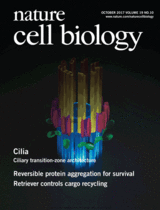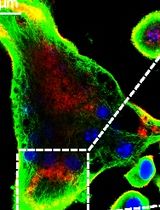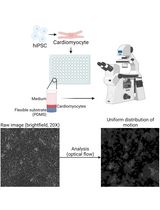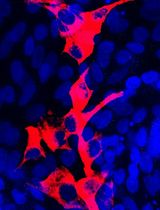- EN - English
- CN - 中文
In vitro Osteoclastogenesis Assays Using Primary Mouse Bone Marrow Cells
原代小鼠骨髓细胞诱导生成体外破骨细胞试验
发布: 2018年06月05日第8卷第11期 DOI: 10.21769/BioProtoc.2875 浏览次数: 11947
评审: Ralph Thomas BoettcherJalaj GuptaCody Kime
Abstract
Osteoclasts are a group of bone-absorbing cells to degenerate bone matrix and play pivotal roles in bone growth and homeostasis. The unbalanced induction of osteoclast differentiation (osteoclastogenesis) in pathological conditions, such as osteoporosis, arthritis and skeleton metastasis of cancer, causes great pain, bone fracture, hypercalcemia or even death to patients. In vitro osteoclastogenesis analysis is useful to better understand osteoclast formation in physiological and pathological conditions. Here we summarized an easy-to-follow osteoclastogenesis protocol, which is suitable to evaluate the effect of different factors (cytokines, small molecular chemicals and conditioned medium from cell culture) on osteoclast differentiation using primary murine bone marrow cells.
Keywords: Osteoclastogenesis (破骨细胞生成)Background
The skeleton is maintained by successive and well-controlled absorbance and formation of bone mass during lifetime. In the bone cavity, each of these two activities is carried out by a specialized cell type: the bone-forming osteoblasts and bone-degrading osteoclasts. Osteoblasts and osteoclasts are derived from bone-resident mesenchymal cells and hematopoietic lineage progenitor cells, respectively. The differentiation of hematopoietic myeloid progenitor cells into mature osteoclasts are majorly controlled by receptor activator of nuclear factor-κB ligand (RANKL, encoded by TNFSF11) and macrophage colony-stimulating factor (M-CSF, encoded by CSF1) derived from osteoblasts and its progenitor cells (Suda et al., 1999). Unlike other cells, osteoclasts differentiate through fusion of a certain number of progenitor cells (Boyle et al., 2003). Thus, a key histological feature of mature osteoclasts is their multiple nuclei. After maturation, osteoclasts are capable of bone resorption by producing an acidified microenvironment to dissolve bone mass mainly composed of calcium phosphate, along with proteases to degrade extracellular matrix (Boyle et al., 2003). The dissolved bone matrix releases sequestered growth factors utilized by osteoblasts to expand their population (Kassem and Bianco, 2015). This cross-talk between osteoblasts and osteoclasts ensures coordinate bone-forming and -degenerating activity, which is dysregulated in a plethora of diseases, including osteoporosis, arthritis and bone metastasis of cancers (Rodan and Martin, 2000; Raisz, 2005; Gupta and Massague, 2006). Based on previous literature (Lu et al., 2009; Wang et al., 2014; Zhuang et al., 2017), here we describe a step-by-step protocol for an in vitro osteoclastogenesis assay using primary murine bone marrow cells that allows studying the effect of a broad range of factors/conditions (such as cytokines and conditioned medium) on osteoclast differentiation.
Materials and Reagents
- Pipet tips (Autoclaved, any brand)
- 29 gauge syringe (BD, catalog number: 328421 )
- 40 µm nylon mesh cell strainer (Corning, catalog number: 352340 )
- Minisart® NML syringe filter, 0.2 µm (Sartorius, catalog number: 17597-K )
- 14 mm round coverslips (any brand suitable for cell culture)
- 24 well plate and 100 mm Petri dish (Thermo Fisher Scientific, NuncTM, catalog numbers: 142475 and 172931 )
- 15 ml conical tubes (Corning, catalog number: 352196 )
- Glass slides (OMANO, catalog number: OMSK-50PL )
- Cell culture Petri dishes and multi-well plate (Thermo Fisher Science, catalog numbers: 174888 , 150350 , 142485 )
- 1.5 ml Eppendorf tubes (Fisher Scientific, catalog number: 05-408-129 )
- Mouse aged between 4-7 weeks (any eligible provider, mouse strain/genetic background should be consistent with other assays)
- α-MEM (Thermo Fisher Scientific, catalog number: A1049001 )
- Fetal bovine serum (Thermo Fisher Scientific, catalog number: 10099141 )
- Recombinant murine M-CSF (PeproTech, catalog number: 315-02 )
- Recombinant murine RANKL (PeproTech, catalog number: 315-11 )
- Red blood cell lysing buffer (BD, catalog number: 555899 )
- Albumin, bovine serum, fraction V (Merck, catalog number: 12659 )
- Acid Phosphatase, Leukocyte (TRAP) Kit (Sigma-Aldrich, catalog number: 387A )
- Acetone (Fisher Scientific, catalog number: A18-1 )
- 37% formaldehyde (Fisher Scientific, catalog number: BP531-500 )
- Neutral Balsam (Sangon Biotech, catalog number: E675007 )
- Sodium chloride (NaCl) (Fisher Scientific, catalog number: BP358 )
- Potassium chloride (KCl) (Sigma-Aldrich, catalog number: P5405 )
- Sodium phosphate dibasic (Na2HPO4) (Sigma-Aldrich, catalog number: S5136 )
- Potassium phosphate monobasic (KH2PO4) (Sigma-Aldrich, catalog number: P5655 )
- Hydrochloric acid (HCl) (Sigma-Aldrich, catalog number: H9892 )
- Culture medium (see Recipes)
- Phosphate buffered saline (see Recipes)
- Murine rRANKL and rM-CSF solution (see Recipes)
Equipment
- Pipette (Eppendorf, sterilize surface by 70% ethanol)
- Hemacytometer (OMANO, catalog number: OMSK-HEMA )
- Dissecting tweezers and scissors (Autoclaved)
Scissors (Fisher Scientific, catalog number: 08-940 )
Tweezers (Fisher Scientific, catalog number: 12-460-612)
Manufacturer: Integra LifeSciences, Integra® Miltex®, catalog number: MH18782 .
Tweezers (Fisher Scientific, catalog number: 12-460-611)
Manufacturer: Integra LifeSciences, Integra® Miltex®, catalog number: MH18780 . - Cell culture incubator (any brand)
- Centrifuge (Thermo Fisher Scientific, model: Hearus Labofuge 400 R )
- Balance
- Inverted microscope (Nikon Instruments, model: Eclipse Ti-S )
- Water bath (any brand which can reach 37 °C)
Procedure
文章信息
版权信息
© 2018 The Authors; exclusive licensee Bio-protocol LLC.
如何引用
Zhuang, X. and Hu, G. (2018). In vitro Osteoclastogenesis Assays Using Primary Mouse Bone Marrow Cells. Bio-protocol 8(11): e2875. DOI: 10.21769/BioProtoc.2875.
分类
发育生物学 > 细胞生长和命运决定 > 退化
细胞生物学 > 细胞分离和培养 > 细胞分化
您对这篇实验方法有问题吗?
在此处发布您的问题,我们将邀请本文作者来回答。同时,我们会将您的问题发布到Bio-protocol Exchange,以便寻求社区成员的帮助。
Share
Bluesky
X
Copy link













